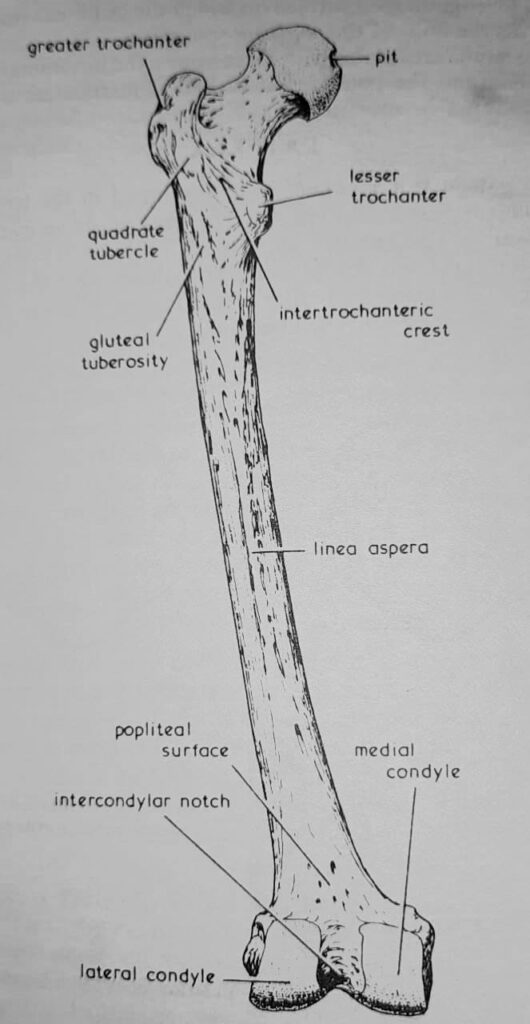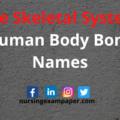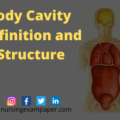The bones of lower limb /extremity are connected with the trunk by means of the pelvic girdle. The lower extremity consists of thirty-one bones each side (Left-Right side), The Lower Limb anatomy bones, and description is given below:
Bones of Lower Limb:
Skeletal System Bones of Lower Limb anatomy bones And lower extremity bones.
- 1 Inominate Bone
- 1 Femur
- 1 Tibia
- 1 Fibula
- 1 Patella
- 7 Tarsal Bones
- 5 Metatarsal Bones
- 14 Phalanges
Lower Limb anatomy bones
The Inominate
The innominate bone or os innominatum helps to form the pelvic girdle. Situated one on each side, uniting in front at the symphysis pubis, the two bones form a considerable part of the bony pelvis or Bones of Lower Limb.
The innominate bone is an irregular flat bone formed by the union of three bones at the acetabulum, which is a cupshaped cavity on the external surface of the bone which receives the head of the femur in the formation of the hip joint.

The uppermost of the three bones which unite here is the ilium, the front one the pubis, and the most posterior the ischium.
The Ilium presents two surfaces, a crest, and an articulating surface for the sacrum.
The crest of the ilium is curved and surmounts the bone. It gives attachment to many muscles, including the abdominal muscles and latissimus dorsi. It terminates in front at a point called the anterior superior iliac spine, to which the inguinal ligament (Poupart’s) is attached, and posteriorly in the posterior superior iliac spine. Below these spines are two other prominences, the anterior and posterior inferior spines. The surface between the two posterior spines forms the articulating surface for the sacrum. Below this articulation lies the greater sciatic notch, through which the sciatic nerve passes from the pelvis to the thigh.
The Pubis consists of a body and two rami. The body is square in shape and is surmounted by the crest of the pubis. The pubic bones unite in front of the symphysis pubis.
The Ischium is the thickest and strongest portion of the bone. The tuberosity of the ischium lies at its lowest point, and on this, the trunk rests when sitting. A pointed eminence, the spine of the ischium, arises from the back of the bone and marks the lowest part of the sciatic notch.
The Obturator Forameu is a large oval foramen lying below, the acetabulum bounded by- the pubis and ischium. It is filled in with membrane, and at its upper part, the obturator vessels and nerves pass from the pelvis into the thigh.

The Acetabulum is a deep, cup-shaped cavity formed by the union of the three bones; the pubis forms the front part, the
The Femur- Longest Bones of Lower Limb
The femur is the longest bone in the body. It articulates with the acetabulum in the formation of the hip joint, and from here the bone inclines medially to the knee, where it articulates with the tibia. It is a long bone with a shaft and two extremities.

The Lower Limb anatomy bones Extremity presents a head that forms two-thirds of a sphere; at the summit of this is an ovoid depression, a roughened pit, for the attachment of the ligamentum teres. Below the head is the neck, which is long and flattened. Where the neck joins the shaft the greater trochanter lies to the outer side, and the lesser trochanter to the back and inner side.
At the base of the neck of the bone, two lines unite the greater and lesser trochanters, the intertrochanteric line in front, and the intertrochanteric crest at the back. The latter is marked by a tubercle of bone, the quadrate tubercle halfway along its length.
The Shaft of the Femur is cylindrical, smooth, and rounded in front, and at the sides. It curves forwards and has a very well marked ridge behind, called the linea aspera, to which a number of muscles are attached, amongst them the adductors of the thigh.
The Lower Extremity is wide and presents two condyles, an intercondylar notch, a popliteal surface, and a patellar surface. The condyles are very prominent; the medial one is lower than the lateral one. They both enter into the formation of the knee joint.
The intercondylar notch separates the condyles behind. The surfaces of this notch give attachment to the cruciate ligaments of the knee joint. The condyles are separated in front by the patellar surface which extends over the anterior aspect of both condyles; on this surface, the patella rests. The tibial surface of the femoral condyles lies below and rests on the upper articulating surface of the condyles of the tibia. This surface is divided into two areas by the deep intercondylar notch. The popliteal surface of the bone lies above the condyles at the back.
It is a lozenge-shaped surface on which the popliteal vessels lie It forms the floor of the popliteal space.
The femur articulates with three bones, the innominate bone the tibia, and the patella, but it does not articulate with the fibula.
Pattela
The patella is a sesamoid bone developed in the tendon of the quadriceps extensor muscle. The apex of the patella points downwards. The anterior surface of the bone is rough. The posterior surface is smooth and articulates with the patellar surface of the lower extremity bone of the femur. It lies in front of but does not enter into the knee joint
Tibia
The tibia or shin bone forms the main skeleton of the leg and lies medial to the fibula; it is a long bone with a shaft and two extremities it’s the other important Bones of the Lower Limb anatomy bones.
The Upper Extremity presents medial and lateral condyles. The condyles form the upper and most expanded portion of the bone. The superior surface of these presents the two plateaulike articulating surfaces for the femur in the formation of the knee joint. These surfaces are smooth, and on their flat surfaces lie the semilunar cartilages, which deepen the articulating surfaces for the reception of the femoral condyles.
The lateral condyle presents a facet posteriorly for articulation with the head of the fibula at the superior tibiofibular joint. The condyles are separated behind by the popliteal notch.
The tubercle of the tibia lies just below the condyles in front. The upper part gives attachment to the patellar tendon, which is the tendon of insertion of the quadriceps extensor muscle. The lower part of the tubercle is subcutaneous, it receives the weight of the trunk in kneeling.#
The
The Lower Extremity enters into the formation of the ankle joint. It is slightly expanded and is prolonged downwards on the medial side as the medial malleolus. The front of the tibia is smooth, and tendons passing to the foot glide over it. The lateral surface of the lower extremity articulates with the fibula at the inferior tibiofibular joint. The tibia articulates with three bones, the femur, fibula, and talus.
FIBULA
The fibula is the lateral bone of the leg. It is a long bone with a shaft and two extremities Lower Limb anatomy bones.
The Upper Extremity forms the head, and articulates with the back of the outer condyle of the tibia, but does not enter into the formation of the knee joint.
The Shaft is slender and deeply embedded in the muscles of the leg, to which it gives numerous attachments.
The Lower Extremity is prolonged downwards as the lateral malleolus.
LOWER EXTREMITY BONES OF THE FOOT
The Tarsal Bones. There are seven bones known collectively as the tarsus. They are short bones, made up of cancellous bone tissue, with a covering of compact tissue. These bones support the weight of the body in standing.
The Calcaneum or Os Calcis is the largest bone of the foot. It lies at the back of the foot forming the heel, transmitting the weight of the body to the ground posteriorly. It gives attachment to the large muscles of the calf through the tendon of Achilles or tendo calcaneus. Above, it articulates with the talus and in front with the cuboid.
The Talus forms the central and highest point of the foot. It supports the tibia and articulates with the malleoli at each side, and with the calcaneum below. Lower Limb anatomy bones
The Navicular, a boat-shaped bone, lies on the medial aspect of the foot, between the talus at the back and the three cuneiform bones in front.
The three Cuneiform Bones articulate with the navicular posteriorly and with the three inner metatarsal bones anteriorly.
The Cuboid is at the lateral aspect of the foot. It articulates with the calcaneum posteriorly and in front with the two lateral metatarsal bones.
The Metatarsal Bones – lower extremity bones: There are five metatarsal bones. These are long bones with a shaft and two extremities, the proximal or tarsal extremity articulating with the tarsal bones, and the distal or phalangeal extremity with the base of the proximal phalanges.
The first metatarsal is thick and short, and the second metatarsal is the longest. ‘
The Phalanges are similar to those of the fingers but much shorter.
The Arches of the foot.
Lower Limb anatomy bones The medial or internal longitudinal arch, which is formed from back to front by the calcaneum, the posterior support of the arch; the talus, the summit of the arch; the navicular- three cuneiform bones; and the heads of the three inner metatarsals, forming the anterior support of the arch.
The lateral or outer longitudinal arch is formed by the calcaneum, the cuboid, and the two outer metatarsal bones.
The transverse arches, of which there are two the transverse tarsal arch formed by the tarsal bones, and the transverse metatarsal arch, commonly known as the posterior transverse metatarsal arch, formed by the heads of these bones, the
The bones of the arches of the foot are held together by ligaments and supported by muscles. These arches are maintained:
- By the close adaptation of the bones.
- By the ligaments of the foot, which are strong.
- By muscular action, particularly by the muscles attached to the front and back of the tibia.
For Download previous year ESIC Exam Question paper CLICK HERE.




